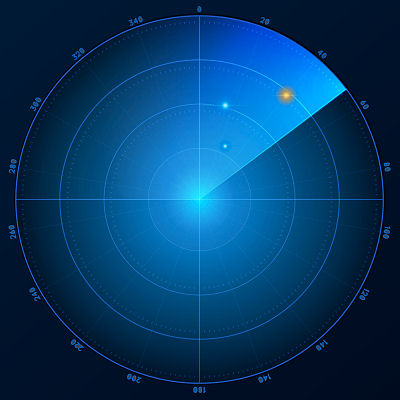Sound As A Tool
We all know of many every day uses of sound as tools in our lives. From the beeping alert of your microwave telling you it's done to various other sounds and uses such as burglar alarms, emergency vehicle sirens. and trains. Even our phone beeps to let us know when I have a message or incoming call. Warning and guiding sounds are common too. Sound assistance can help a blind person cross the street. Even a whistle can be used to call your dog. The possibilities of using sound as tools are endless.
 Naval warships carry a device known as sonar used for detecting other vessels or objects underwater such as mines. Sonar transmits a sound whose resonant frequency sound waves travel through the water and bounce back when striking an object. By receiving and interpreting the strengths and characters of the return sound wave, Naval personnel can determine things such as the size of the object or even its precise location. This use of sound as a tool could also be construed as use as a weapon of both defensive and offensive capability. For example, knowing exactly location of an enemy submarine could enable the Naval vessel to launch an attack upon or in defense. Sonar and sound have both proven invaluable in military applications and many other useful and practical purposes.
Naval warships carry a device known as sonar used for detecting other vessels or objects underwater such as mines. Sonar transmits a sound whose resonant frequency sound waves travel through the water and bounce back when striking an object. By receiving and interpreting the strengths and characters of the return sound wave, Naval personnel can determine things such as the size of the object or even its precise location. This use of sound as a tool could also be construed as use as a weapon of both defensive and offensive capability. For example, knowing exactly location of an enemy submarine could enable the Naval vessel to launch an attack upon or in defense. Sonar and sound have both proven invaluable in military applications and many other useful and practical purposes.
The Wonder of Voice
The human voice is a wonder. Our speech is likely the most common use of sound as a tool we know of. Without vocal chords, we'd be muted. Living in a vocally silent world would certainly leave a negative effect on relationships. Making sign language or writing it down just doesn't carry the same weight as saying 'I love you' or shouting 'Watch out!' I'd say our voice is the most important use of sound as a tool the world over. It's a wonder for sure.
I'm glad we have the ability to talk, yell, whisper, and sing. Without voice, what would we record other than music forever unsung? It kind of puts a spin on 'The Sound of Silence' doesn't it? The very first successful sound recording was that of a 435 hz tuning fork made by Edouard-Leon Scott de Martinville in 1857, followed by the first recording of his human voice singing the tune 'Au Clair de la Lune' thus birthing the earliest in musical recording.
Animals too have a voice. Some can even sing. These I include among the 'natural music' phenomenon. Nature makes music though some of us might not think of it as more than a disturbance but it can be useful. Rumbling thunder tells us that a storm is nearby or crashing waves upon the seashore show us that even the ocean has a rhythm. That growling dog sneaking up from behind is something I'd want to hear. Humpback whales have been recorded singing songs that can travel for miles under the sea. Some birds and insects have a singing voice which is inaudible to humans but we know it's there due to a response in nature and from other creatures. Cats of all kinds roar, growl, and purr. I'm glad. If there were no voice, there'd be no reason to sing. Therein lies the true wonder of voice. We can use it to speak a language, to make sounds and innumerable noises, or to make music singing, humming, or chanting. See Naturally Occurring Music.
Resonance and Sound Waves
All objects possess what is known as a natural frequency, or a frequency at which that object vibrates. If you tap a fork against a wineglass, the tinkling sound it produces is its natural frequency. Any sound reproducing that same natural frequency will cause the glass to vibrate. This common phenomenon is known as resonance and occurs because the sound displaces nearby air particles which crash into the glass like invisible waves. When the sound is amplified, these waves get more powerful. With enough amplification, objects can vibrate so strongly that they break. All sounds travel on sound waves which are based on the frequency. Its frequency is defined as a specific measured pressure against a medium such as air.
Resonance in Music
To me music too is one of our most valueable uses of sound as tools. Actually, the musical instrument is the tool here. With musical instruments we can produce the melodic sounds which we humans are incapable of. Few of us can actually break glass with our voice so we use instruments to break hearts instead.. or heal them using combinations of sounds at just the right pitches required to touch the human soul. Now that's working for a living.
Various musical instruments are made specifically to produce a resonant sound. This adds a harmonic effect to the instrument's tone. For example acoustic resonators, an early make of blues guitar are built to produce resonant tones. Other instruments as well have built in resonant qualities for harmonic effects. The harmonica does this well along with other acoustic box body instruments. In music, resonance is produced in a number of ways such as different instrumental combinations and the use of harmonic and enharmonic chords. Hence the term harmony.
It is sound effects like these that cause the music listener to feel waves of emotional rushes through their senses via resonant tones or chords when listening to music, whether it be prerecorded or performed live. So the next time the music makes you cry or jump up and dance you'll know why. It's harmonic resonance. The music actually contains sounds that resonate with not only our body but our spirit too. After all, isn't that music is all about? See also Infrasound.
 -
-


